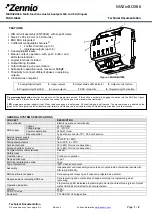
DocID022799 Rev 10
21/135
STM32L151xC STM32L152xC
Functional overview
52
3.4 Clock
management
The clock controller distributes the clocks coming from different oscillators to the core and
the peripherals. It also manages clock gating for low-power modes and ensures clock
robustness. It features:
•
Clock prescaler
: to get the best trade-off between speed and current consumption, the
clock frequency to the CPU and peripherals can be adjusted by a programmable
prescaler.
•
Safe clock switching
: clock sources can be changed safely on the fly in run mode
through a configuration register.
•
Clock management
: to reduce power consumption, the clock controller can stop the
clock to the core, individual peripherals or memory.
•
System clock source
: three different clock sources can be used to drive the master
clock SYSCLK:
–
1-24 MHz high-speed external crystal (HSE), that can supply a PLL
–
16 MHz high-speed internal RC oscillator (HSI), trimmable by software, that can
supply a PLL
–
Multispeed internal RC oscillator (MSI), trimmable by software, able to generate 7
frequencies (65 kHz, 131 kHz, 262 kHz, 524 kHz, 1.05 MHz, 2.1 MHz, 4.2 MHz).
When a 32.768 kHz clock source is available in the system (LSE), the MSI
frequency can be trimmed by software down to a ±0.5% accuracy.
•
Auxiliary clock source
: two ultra-low-power clock sources that can be used to drive
the LCD controller and the real-time clock:
–
32.768 kHz low-speed external crystal (LSE)
–
37 kHz low-speed internal RC (LSI), also used to drive the independent watchdog.
The LSI clock can be measured using the high-speed internal RC oscillator for
greater precision.
•
RTC and LCD clock sources:
the LSI, LSE or HSE sources can be chosen to clock
the RTC and the LCD, whatever the system clock.
•
USB clock source:
the embedded PLL has a dedicated 48 MHz clock output to supply
the USB interface.
•
Startup clock
:
after reset, the microcontroller restarts by default with an internal 2 MHz
clock (MSI). The prescaler ratio and clock source can be changed by the application
program as soon as the code execution starts.
•
Clock security system (CSS):
this feature can be enabled by software. If a HSE clock
failure occurs, the master clock is automatically switched to HSI and a software
interrupt is generated if enabled.
•
Clock-out capability (MCO: microcontroller clock output):
it outputs one of the
internal clocks for external use by the application.
Several prescalers allow the configuration of the AHB frequency, each APB (APB1 and
APB2) domains. The maximum frequency of the AHB and the APB domains is 32 MHz. See
















































